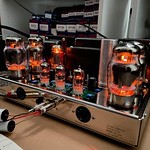 by Peter W. Thu Jan 19, 2017 2:45 pm
by Peter W. Thu Jan 19, 2017 2:45 pm
You are wrong.
Matching, properly done, includes that the Gm ( amplification ability ) is also selected
as a parameter. If not matched it would be the equivalence of different size pistons
in the same engine.[/quote]
OK - let's cut to the chase. There are two (basic) reasons for matching:
Electrical - so that one tube of a pair does not become a current-sink and wear itself out very quickly at best, slag itself at worst.
Performance - so that the tubes are approximately even in amplification performance.
The reasons for the former are pretty obvious, and the consequences for ignoring the need equally obvious. But, individual bias capacity eliminates the penalty. Further to this - electrical matching is a momentary thing given the generally poor quality of modern tubes. Once upon a time electrical matching would remain tolerable over the life of the tube as QC was very nearly infinitely better than now, such that the aging process was reasonably predictable. A tube match to 5% today was likely within 10% or so withing its service life. That level of predictability is no longer possible. Individual biasing is the proper answer. Writing only for myself, were I to have to use modern production tubes in my 70, I would immediately move to a VTA board or-equal as individual biasing would be necessary for safe operation.
Now to the latter: In point of fact, have a look at the process behind the Atkinson Cycle engine (patented in 1887). There is no penalty for "different size pistons" (not quite, but very close to that) in the same engine if that is accommodated in the design. That one tube may do 70% of the work, another only 30% is not at issue as long as there is no electrical penalty.
As we have established that the tube-under-discussion suffered a mechanical failure, not an electrical one, I would revise my advice to LeGrace - yes, replacing one tube of a pair, while not ideal, is perfectly OK as long as the bias across the board is set-and-correct. Once more writing for myself, I prefer replacing in pairs. But if not electrically dead, my 'pulls' will be retained for individual re-matching as future short-term replacements. typically only one of any given pair is either compromised sufficiently for disposal or stone dead.
As compared to any given Revox solid-state amp, those of us driving tubes are back in the stone-age in terms of complexity. These devices are rugged, and with very little mystery attached.
Again, horses for courses.



